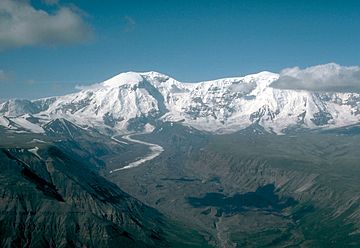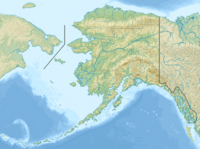Mount Jarvis facts for kids
Quick facts for kids Mount Jarvis |
|
|---|---|

Mount Jarvis from the northeast
|
|
| Highest point | |
| Elevation | 13,421 ft (4,091 m) |
| Prominence | 4,721 ft (1,439 m) |
| Listing |
|
| Geography | |
| Parent range | Wrangell Mountains |
| Topo map | USGS Nabesna A-6 |
| Geology | |
| Age of rock | 1.7 – 1.0 million years |
| Mountain type | Eroded shield volcano |
| Last eruption | Dacite flow, 1.0 million years ago |
| Climbing | |
| Easiest route | Glacier climb |
Mount Jarvis is a large, old shield volcano located in the Wrangell Mountains of eastern Alaska. It is found inside Wrangell-Saint Elias National Park. The mountain sits about 10 miles (16 km) east of the top of Mount Wrangell. Mount Jarvis rises almost 5,000 feet (1,524 meters) above the huge ice-covered area around it. It features amazing cliffs and icefalls.
Contents
The Shape and Size of Mount Jarvis
From high above, Mount Jarvis looks a bit like a dumbbell. It has two main peaks connected by a narrower ridge. The main peak of Mount Jarvis is 13,421 feet (4,091 meters) tall. This makes it one of many "thirteeners" in Alaska. A thirteener is a mountain peak that is between 13,000 and 13,999 feet high.
Two Peaks of Mount Jarvis
The second peak of Mount Jarvis is about 3 miles (5 km) to the north-northwest. It reaches 13,025 feet (3,970 meters) in height. This second peak is also considered an independent thirteener. This is because it rises more than 725 feet (221 meters) above the ridge that connects it to the main peak.
Ice and Glaciers
The entire top area of Mount Jarvis, including both peaks and the connecting ridge, is covered in glacial ice. The eastern and western sides of Mount Jarvis are very steep and rocky. These sides form headwalls above the cirques (bowl-shaped valleys) of the Jacksina Glacier and Copper Glacier. These glaciers flow northward out of the Wrangell Mountains.
How Mount Jarvis Got Its Name
Mount Jarvis was named in 1903 by a geologist named F. C. Schrader. He worked for the USGS. The mountain was named after Lieutenant David H. Jarvis. Lt. Jarvis was part of the United States Revenue Cutter Service. He led a special trip called the Overland Relief Expedition. This trip helped a group of whaling ships that were stuck in the ice of the Arctic Ocean. This happened near Point Barrow in 1897–98.


